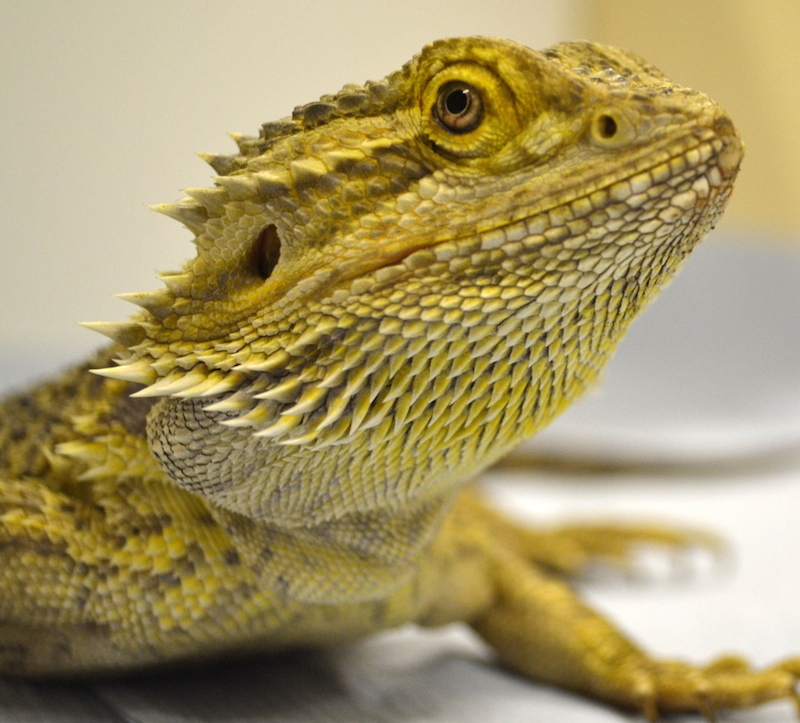'Copycat' Bearded Dragons Mimic Their Peers

The scaly bearded dragon is the first reptile to show it can imitate a peer, and all for the price of a mealworm, new research suggests.
In a new study, researchers trained a 3-year-old female bearded dragon (Pogona vitticeps) how to open a sliding screen door with her head. Once successful, the lizard entered the doorway and ate a mealworm prize. Other bearded dragons then watched a video of the lizard opening the door, and scientists monitored whether the other animals imitated the behavior.
All eight bearded dragons that watched the 11-second video of the demonstrator lizard followed suit. They opened the door in exactly the same manner as the bearded dragon in the video did, the researchers said. In contrast, the four lizards that did not see the video failed to open the door. [The 5 Smartest Non-Primates on the Planet]
"The ability to learn through imitation is thought to be the pinnacle of social learning and long considered a distinctive characteristic of humans," lead researcher Anna Wilkinson, a senior lecturer of animal cognition at the University of Lincoln, in the United Kingdom, said in a statement. "However, nothing is known about these abilities in reptiles."
It's unlikely that the successful lizards were showing spontaneous behavior, as they all opened the door in the same way as shown in the video, Wilkinson said. Their behavior suggests that they were imitating the demonstrator lizard to get to the mealworms.
"This research suggests that the bearded dragon is capable of social learning that cannot be explained by simple mechanisms — such as an individual being drawn to a certain location because they observed another in that location or through observational learning," Wilkinson said. "The finding is not compatible with the claim that only humans — and to a lesser extent, great apes — are able to imitate."
Scientists previously thought only humans and advanced primates, such as chimpanzees, could imitate one another. True imitation is a complex behavior; it requires that an animal copy the behavior of another and understand the meaning behind it. This is different from emulation, in which an animal copies a behavior without understanding its implications. For instance, a parrot might repeat a phrase, but not realize what it's saying.
Sign up for the Live Science daily newsletter now
Get the world’s most fascinating discoveries delivered straight to your inbox.
Recent research, however, shows that imitation may be more common that previously thought. Apes, such as wild chimpanzees, gorillas and orangutans, imitate each other, as can monkeys, including wild marmosets and rhesus macaques. Birds, such as pigeons and zebra finches, and other mammals have also joined the club. Mimicking mammals include dogs, bottlenose dolphins and the banded mongoose.
This isn't Wilkinson's first foray into the world of reptile cognition. Earlier this year, she and her colleagues showed that turtles could learn how to use a touch-screen computer.
Reptiles and mammals share a common ancestor, and understanding the behavioral similarities and differences between the two groups of animals may help researchers tease apart the evolution of cognition, Wilkinson said. It's likely that the ability to imitate is based on ancient mechanisms, she added.
"These results reveal the first evidence of imitation in a reptile species and suggest that reptiles can use social information to learn through imitation," she said.
The study was published online Sept. 9 in the journal Animal Cognition.
Follow Laura Geggel on Twitter @LauraGeggel and Google+. Follow Live Science @livescience, Facebook & Google+. Original article on Live Science.

Laura is the archaeology and Life's Little Mysteries editor at Live Science. She also reports on general science, including paleontology. Her work has appeared in The New York Times, Scholastic, Popular Science and Spectrum, a site on autism research. She has won multiple awards from the Society of Professional Journalists and the Washington Newspaper Publishers Association for her reporting at a weekly newspaper near Seattle. Laura holds a bachelor's degree in English literature and psychology from Washington University in St. Louis and a master's degree in science writing from NYU.









